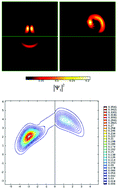Graphene levitons and anti-levitons in magnetic fields†
Abstract
The leviton is an electron or hole wavepacket that rides the surface of the Fermi sea. When a series of Lorentzian or Gaussian time dependent pulses are applied to an ultracold system a soliton-like excitation with only one electron and no localised hole emerges. Graphene is a unique system where the Fermi surface may arise from a Dirac point and therewith the levitons character may display many interesting features. For example, the leviton formation may be associated with a chiral anomaly, and inside a single potential step an anti-leviton forms. We show that the application of weak magnetic fields may switch on and off the leviton Klein tunnelling. Also, in a moderate field negative refraction arises along a curved trajectory, whereas with a stronger field a new elementary excitation – the levity vortex – in the reflected wavefunction occurs. Herein we describe these phenomena in detail along with a complete explanation of the transmission of graphene levitons at a step potential in terms of the probability densities and a series of phase diagrams and the tunnelling times.


 Please wait while we load your content...
Please wait while we load your content...